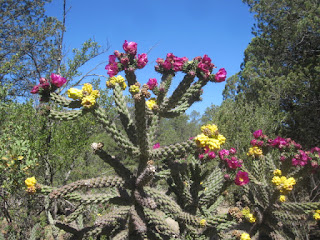We awake to the gentle sounds of the Bear Mountain Lodge. Birds singing, the wind rustling the trees.
Amy heads out for a run while I laze. When she returns, we get ready for
breakfast, then descend the stairs to the beautiful dining area. The menu is
home-made granola with fruit and yogurt and blueberry French
Toast with a side of bacon.
Before we hit the road, we take a short walk around the
Lodge. They have some really interesting plants here:
 |
| Dr. Suess Bush? |
 |
| Flowering Cactus |
We leave the Lodge and head back 4 miles into Silver City to
get a full tank of gasoline. We have a long way to drive today. It is 232 miles
to our next lodging at Socorro, NM. After assuring a full tank to get there, the first feature we drive through is the
Gila National Forest. It is quite beautiful.
 |
| Gila National Forest |
The highway takes us up and over two passes on our way to
the small town of Datil. As we descend the last pass, the vegetation thins out
to high dessert.
 |
| Approaching Datil |
As we drive east from Datil, we approach the day’s site of
interest, the Very Large Array. We stop at the turnout that is the closest
point to it on US 60 and take a few pictures.
 |
| The Very Large Array |
The VLA is a huge scientific
machine. It is a radio telescope made up of 27 separate 270 Ton Parabolic
Dishes. The dishes can be reconfigured into 4 different arrangements, allowing
exceedingly precise views of the cosmos. Already the VLA has discovered 2
suspected black holes in our very own Milky Way Galaxy.
We get back on the road and as we
continue east, we see a sign for a Visitor’s Center. Oops, faulty planning as I didn't know this was here. We don’t often get the
opportunity to be Science Nerds where it is socially acceptable, so we head in
to take a look. The tour starts with a documentary film, narrated by Jodie
Foster (remember the movie Contact?).
Then we proceed outside to the walking tour. It’s really cool that they let the
public get so close to the machines, but they warn us that cell phones must be
OFF as their radio emissions can interfere with the signals that the antennas
detect and relay back to the data center. In fact, the cell phones are hundreds
of times stronger than the signals the antennas are detecting.
Which brings us to why the VLA is
in this particular place, out in the middle of nowhere. The first reason
relates to the ambient electronic background. With very little population
within a 100 mile radius, there is less background noise, so a better signal to
noise ratio. Also, geographically speaking, this is a great location: we are on
the bed of an ancient ocean floor. It is flat and it is in a bit of a
depression surrounded by a rim of low mountains. This, too, helps to keep the noise
from far-off cities (and people) low. And since it is flat, the antennas can be
moved more easily. Finally, this site is at almost 7,000 ft. elevation. Sensing
the radio waves before they get distorted by that extra 7,000 ft. of the dense
atmosphere allows for a better signal detection.
One stop on the walking tour allows
us to get a feel for just how big the dishes are.
 |
| Amy Next to an Antenna |
Other parts of the VLA are equally
surprising. All of the dishes feed their observations to an air-conditioned
supercomputer storehouse. During operation, which is most of the time, the
supercomputer makes 4 quadrillion computations a second (1 quadrillion is 1,000
trillion) to correlate the observations in real-time to reduce the data into a
more easily saved “picture”.
While there are 27 antennas in the
array at all times, there are actually 28 antennas. One is always “swapped out”
and in the barn for regular maintenance or upgrade. The VLA was built from 1973
to 1980. You might think that a radio telescope based on 37 year old technology
would be out of date, but in 2011, they completely upgraded all the antennas’ internal
electronics.
 |
| Spare Dish in the Barn |
The method for moving and
repositioning the antennas uses the orange machine in front of the antenna in
the photo above. That machine is called a lifting locomotive and can move a 270 ton dish using the rail system of the VLA. It moves antennas at about 2
MPH. The rails access all potential antenna sites. The lifting locomotive can
set the antenna down, then turn itself 90 degrees to use a new set of rails,
then move the antenna down the different track. You can see some rails in the
foreground of the above photo. Once an antenna has been sited and released by
the lifting locomotive, it can be active in the array within 15 minutes.
I am overwhelmed to be here. This is one of science’s most marvelous
instruments. And here it is being used on the quest for knowledge of our universe.
Scientists carrying on the legacy of Galileo!
Having totally geeked out, we purchase some souvenirs at the
visitor center (Wayne a T-Shirt, Amy an Apron). Then we get back on the road
and travel the remaining 50 miles to the Holiday Inn Express in Socorro. We
have a filling dinner at the Socorro Springs Brewing Company one block away.
This has been a fun day. Beautiful scenery for hours and a visit to one of the most advanced and complicated scientific instruments on the planet.
No comments:
Post a Comment